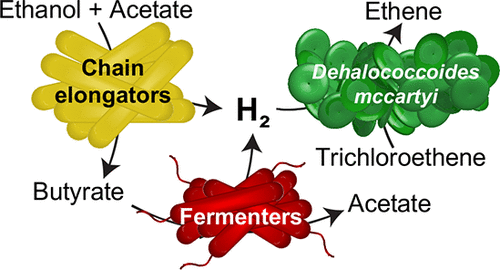当前位置:
X-MOL 学术
›
Environ. Sci. Technol.
›
论文详情
Our official English website, www.x-mol.net, welcomes your feedback! (Note: you will need to create a separate account there.)
Microbial Chain Elongation and Subsequent Fermentation of Elongated Carboxylates as H2-Producing Processes for Sustained Reductive Dechlorination of Chlorinated Ethenes
Environmental Science & Technology ( IF 11.4 ) Pub Date : 2021-07-20 , DOI: 10.1021/acs.est.1c01319 Aide Robles 1, 2, 3 , Theodora L Yellowman 1, 3 , Sayalee Joshi 1, 2, 3 , Srivatsan Mohana Rangan 1, 2, 3 , Anca G Delgado 1, 2, 3
Environmental Science & Technology ( IF 11.4 ) Pub Date : 2021-07-20 , DOI: 10.1021/acs.est.1c01319 Aide Robles 1, 2, 3 , Theodora L Yellowman 1, 3 , Sayalee Joshi 1, 2, 3 , Srivatsan Mohana Rangan 1, 2, 3 , Anca G Delgado 1, 2, 3
Affiliation

|
In situ anaerobic groundwater bioremediation of trichloroethene (TCE) to nontoxic ethene is contingent on organohalide-respiring Dehalococcoidia, the most common strictly hydrogenotrophic Dehalococcoides mccartyi (D. mccartyi). The H2 requirement for D. mccartyi is fulfilled by adding various organic substrates (e.g., lactate, emulsified vegetable oil, and glucose/molasses), which require fermenting microorganisms to convert them to H2. The net flux of H2 is a crucial controlling parameter in the efficacy of bioremediation. H2 consumption by competing microorganisms (e.g., methanogens and homoacetogens) can diminish the rates of reductive dechlorination or stall the process altogether. Furthermore, some fermentation pathways do not produce H2 or having H2 as a product is not always thermodynamically favorable under environmental conditions. Here, we report on a novel application of microbial chain elongation as a H2-producing process for reductive dechlorination. In soil microcosms bioaugmented with dechlorinating and chain-elongating enrichment cultures, near stoichiometric conversion of TCE (0.07 ± 0.01, 0.60 ± 0.03, and 1.50 ± 0.20 mmol L–1 added sequentially) to ethene was achieved when initially stimulated by chain elongation of acetate and ethanol. Chain elongation initiated reductive dechlorination by liberating H2 in the conversion of acetate and ethanol to butyrate and caproate. Syntrophic fermentation of butyrate, a chain-elongation product, to H2 and acetate further sustained the reductive dechlorination activity. Methanogenesis was limited during TCE dechlorination in soil microcosms and absent in transfer cultures fed with chain-elongation substrates. This study provides critical fundamental knowledge toward the feasibility of chlorinated solvent bioremediation based on microbial chain elongation.
中文翻译:

微生物链延长和随后发酵延长的羧酸盐作为持续还原脱氯氯乙烯的 H2 生产过程
三氯乙烯 (TCE) 对无毒乙烯的原位厌氧地下水生物修复取决于呼吸有机卤化物的Dehalococcoidia,这是最常见的严格氢营养型 Dehalococcoides mccartyi ( D. mccartyi )。D. mccartyi对 H 2 的需求通过添加各种有机底物(例如,乳酸盐、乳化植物油和葡萄糖/糖蜜)来满足,这需要发酵微生物将它们转化为 H 2。H 2的净通量是生物修复功效的关键控制参数。H 2竞争微生物(例如产甲烷菌和同型产乙酸菌)的消耗会降低还原脱氯的速度或完全停止该过程。此外,一些发酵途径不产生H 2或具有H 2作为产物在环境条件下在热力学上并不总是有利的。在这里,我们报告了微生物链延长作为还原脱氯的 H 2生产过程的新应用。在用脱氯和链延长富集培养物进行生物增强的土壤微观世界中,TCE 的化学计量转化率接近化学计量比(0.07 ± 0.01、0.60 ± 0.03 和 1.50 ± 0.20 mmol L –1当最初通过乙酸盐和乙醇的链延长刺激时,可实现(顺序添加)到乙烯中。链伸长通过在乙酸盐和乙醇向丁酸盐和己酸盐的转化过程中释放 H 2来引发还原性脱氯。丁酸盐(一种链延长产物)合成发酵为 H 2和乙酸盐,进一步维持了还原脱氯活性。在土壤微观世界中的 TCE 脱氯过程中产甲烷受到限制,而在用链伸长底物喂养的转移培养物中不存在。这项研究为基于微生物链延长的氯化溶剂生物修复的可行性提供了关键的基础知识。
更新日期:2021-08-03
中文翻译:

微生物链延长和随后发酵延长的羧酸盐作为持续还原脱氯氯乙烯的 H2 生产过程
三氯乙烯 (TCE) 对无毒乙烯的原位厌氧地下水生物修复取决于呼吸有机卤化物的Dehalococcoidia,这是最常见的严格氢营养型 Dehalococcoides mccartyi ( D. mccartyi )。D. mccartyi对 H 2 的需求通过添加各种有机底物(例如,乳酸盐、乳化植物油和葡萄糖/糖蜜)来满足,这需要发酵微生物将它们转化为 H 2。H 2的净通量是生物修复功效的关键控制参数。H 2竞争微生物(例如产甲烷菌和同型产乙酸菌)的消耗会降低还原脱氯的速度或完全停止该过程。此外,一些发酵途径不产生H 2或具有H 2作为产物在环境条件下在热力学上并不总是有利的。在这里,我们报告了微生物链延长作为还原脱氯的 H 2生产过程的新应用。在用脱氯和链延长富集培养物进行生物增强的土壤微观世界中,TCE 的化学计量转化率接近化学计量比(0.07 ± 0.01、0.60 ± 0.03 和 1.50 ± 0.20 mmol L –1当最初通过乙酸盐和乙醇的链延长刺激时,可实现(顺序添加)到乙烯中。链伸长通过在乙酸盐和乙醇向丁酸盐和己酸盐的转化过程中释放 H 2来引发还原性脱氯。丁酸盐(一种链延长产物)合成发酵为 H 2和乙酸盐,进一步维持了还原脱氯活性。在土壤微观世界中的 TCE 脱氯过程中产甲烷受到限制,而在用链伸长底物喂养的转移培养物中不存在。这项研究为基于微生物链延长的氯化溶剂生物修复的可行性提供了关键的基础知识。



























 京公网安备 11010802027423号
京公网安备 11010802027423号